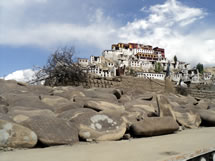about leh
 Leh, the capital of Ladakh is situated at a height of 3505 meters and is towards the eastern parts of Jammu and Kashmir. Ladakh has four major mountain ranges - The great Himalayan, Zanskar, Ladakh and the Karakoram, passing through it The region is watered by the Zanskar River, which flows into the Indus River just below. Spilling out of a side valley that tapers north towards eroded snow-capped peaks, the Ladakhi capital sprawls from the foot of a ruined Tibetan style palace - a maze of mud-brick and concrete flanked on one side by cream-coloured desert, and on the other by a swathe of lush irrigated farmland. As one approaches Leh India for the first time, via the sloping seep of dust and pebbles that divide if from the floor of the Indus Valley, one will have little difficulty imagining how the old trans -Himalayan traders must have felt as they plodded in on the caravan routes from Yarkhand and Tibet: a mixture of relief at having crossed the mountains in one piece, and anticipation of a relaxing spell in one of central Asia's most scenic and atmospheric towns. Leh in India is a beautiful destination with so many attractions and is the center of Tibeto-Buddhist Culture for ages. Its colorful gompas have attracted the devout Buddhists from all over the globe. Besides, it is also a favorite hiking locale and is known for some of the best hikes in the country. Travel to leh this vacation to enjoy its mystic beauty, nut before that acquaint yourself a little bit about the past and present of Leh India.
Leh, the capital of Ladakh is situated at a height of 3505 meters and is towards the eastern parts of Jammu and Kashmir. Ladakh has four major mountain ranges - The great Himalayan, Zanskar, Ladakh and the Karakoram, passing through it The region is watered by the Zanskar River, which flows into the Indus River just below. Spilling out of a side valley that tapers north towards eroded snow-capped peaks, the Ladakhi capital sprawls from the foot of a ruined Tibetan style palace - a maze of mud-brick and concrete flanked on one side by cream-coloured desert, and on the other by a swathe of lush irrigated farmland. As one approaches Leh India for the first time, via the sloping seep of dust and pebbles that divide if from the floor of the Indus Valley, one will have little difficulty imagining how the old trans -Himalayan traders must have felt as they plodded in on the caravan routes from Yarkhand and Tibet: a mixture of relief at having crossed the mountains in one piece, and anticipation of a relaxing spell in one of central Asia's most scenic and atmospheric towns. Leh in India is a beautiful destination with so many attractions and is the center of Tibeto-Buddhist Culture for ages. Its colorful gompas have attracted the devout Buddhists from all over the globe. Besides, it is also a favorite hiking locale and is known for some of the best hikes in the country. Travel to leh this vacation to enjoy its mystic beauty, nut before that acquaint yourself a little bit about the past and present of Leh India.
Air Travel
Indian Airlines operates regular flights to Leh from Delhi, Four flights in a week from Jammu and once in a week from Chandigarh and twice from Srinagar. Jet Airways operates daily flights between Leh-Delhi
General Informations
Ladakh is spread over an area of 97,000 sq. kms. and lies at an average altitude of 3,500m above the sea level. Ladakh has a population of around 2,5000.
Languages Spoken
Ladakhi is the main language of Ladakh; other languages spoken are Balti, Shina, Brokshat and Changshat. In hotels and restaurants staff speak English and Hindi, while tourist guides are well versed with the language.
Permit and Passport
Tourist don't require permit for Leh, however, all foreigners are required to be registered at Drass, Rumtse and Serchu if they are travelling overland. Those traveling by air get themselves registered at airport. Tourists are required to get permit for restricted areas like Tsomoriri, Tsokar and Pangong Lakes, Dhahanu and Nubra Valley.
